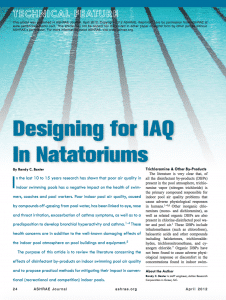History of Indoor Air Quality (IAQ) | Part 2
Part%202_English_v1.jpg)
Continued from History of indoor pool air quality (IAQ) | Part 1.
The indoor pool air quality alliance’s origins

Before going any further, read this brief background story about Paddock, the pool equipment manufacturer. While the story has nothing to do with Orenda, it has everything to do with indoor pool air quality.
Paddock listened to Randy Baxter, and started thinking of how to evacuate airborne disinfectant byproducts (DBPs) like chloramines. Paddock—a pool company—was crossing into the HVAC world. It may sound silly now, but it was a big deal at the time, and it was not well received. The HVAC industry largely rejected the idea that they could do more, and that air quality in natatoriums actually fell under their responsibility. It was much easier to blame the aquatics director.
Over the next few years, however, Paddock Evacuator’s success grew. They continued installing more systems. They continued improving their technology. They continued proving experts and naysayers wrong. They were improving air quality so drastically, that even ASHRAE, the leading association of the HVAC industry, took notice. In April, 2012, they invited Baxter to publish his opinion in the ASHRAE journal, which was a turning point. The HVAC industry began to accept what Paddock had been saying and doing. They began to listen, and the alliance was about to begin.
Within about 18 months of that ASHRAE article, nearly every major pool dehumidification company had embraced Paddock’s Evacuator technology, and had designed their systems to incorporate it into their product offering. It made sense for them, since the Evacuator did things their machines couldn’t do, and the Evacuator is not effective without a working HVAC system with a good duct design. Teaming up to coordinate on a pool design saved everyone time, money, and risk.
An amazing thing happened. Fresh, healthy air became not only possible, but the new standard of care.
The Industry’s new position
Coordination—fueled by a swimmer-first design philosophy—has become critical in the design process. Ignoring a piece of the puzzle for savings (either of cost or time) tends to open the floodgates to more problems down the road. Engineers and architects have recognized it. In other words, both industries have recognized that you get what you pay for. Do not cut corners, speak openly within the design team, and the risk of air quality issues will decrease.
It is also understood that there is no magic pill to cure bad pool air quality. No one product or system can do it all. You have to have several things on the air side working together, and several things on the water side. So let’s cover them.
Best practices for healthy pool air quality
HVAC
- If using a dehumidification system, be sure it is sized properly to handle the amount of outdoor air (OA) needed to serve the pool. Major pool dehumidification manufacturers know these specs and should be involved in the design process, to help guide the mechanical engineer.
- Regular air conditioners are not built for natatoriums, and should not be used. There are many reasons for this. Invest the extra money in a system specifically made for indoor pools, rather than having to constantly repair your air conditioner. It will save you money in the long run.
 Use source-capture technology (Evacuator) to handle airborne toxins, which will keep the contaminants out of the dehumidifier’s recirculation loop. This is arguably the most important difference maker to achieve great pool air quality.
Use source-capture technology (Evacuator) to handle airborne toxins, which will keep the contaminants out of the dehumidifier’s recirculation loop. This is arguably the most important difference maker to achieve great pool air quality.
AQUATICS
- Use automatic feeder systems to control your pool chemicals
- Test water regularly. Not just for chlorine and pH, but also for calcium hardness, phosphates and total alkalinity.
- Shock the pool only when necessary, not as a regular practice.
- Since chloramines (and other DBPs) are the result of chlorine getting used up on carbon and nitrogen-based bather waste, curtail organic loading with a regular dosing of enzymes. This should reduce chlorine demand. Note, you will still have airborne DBPs, just less of them.
- Test your tap water (fill water) so you have a baseline of what is going into your pool. Understanding the chlorine, phosphate, calcium hardness and pH levels of your tap water can make pool management less of a headache.
- Have a secondary system—like UV or Ozone—installed on your pool. It helps reduce waterborne DBPs, though it cannot help what has already gone airborne.
- As a rule of thumb, if you find yourself adding more and more chemicals to get things under control, you're probably making the problem worse. It's okay to ask for help from an outside expert, and people are available to help. We're all on the same team.
Above all, understand that no one product on the market can do it all. No single method or system will give you great air quality. It takes a coordinated effort between air and water systems, but it can be done.
